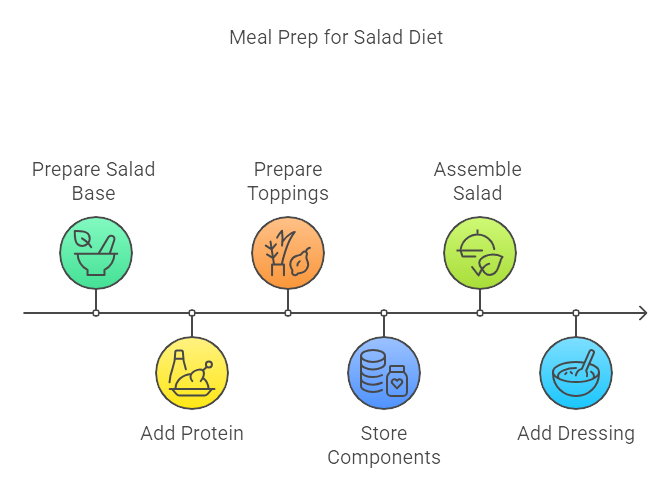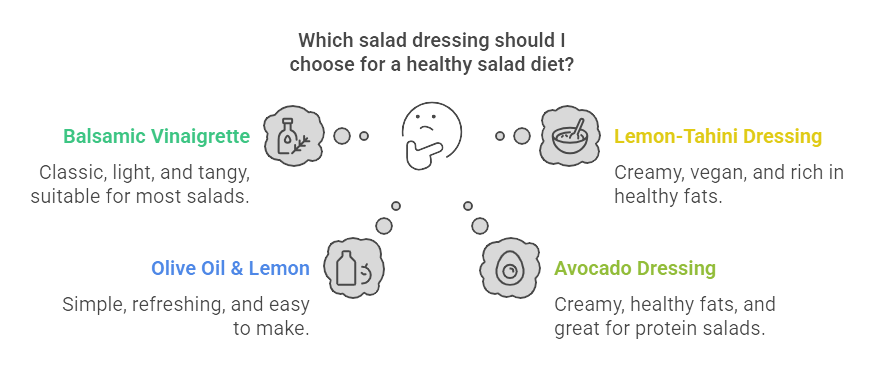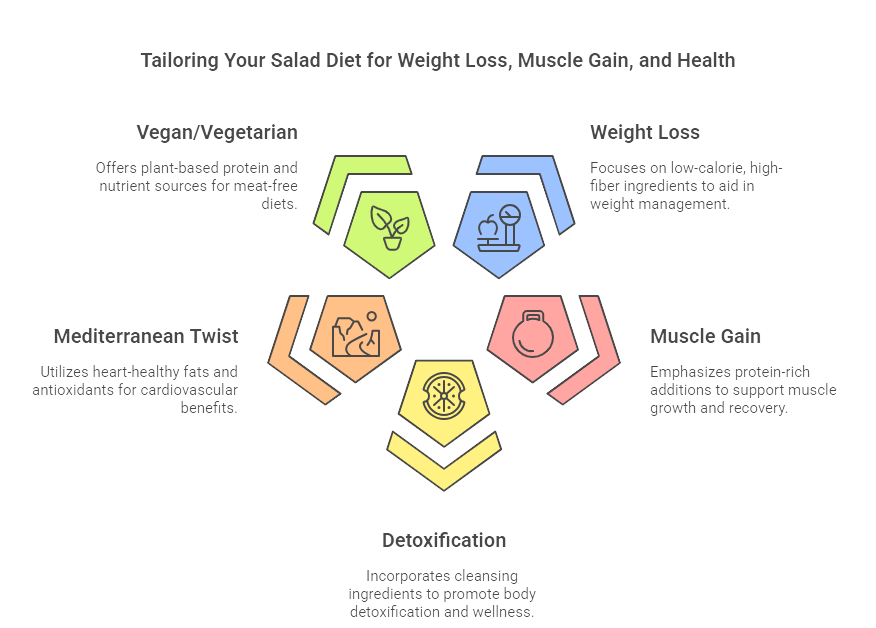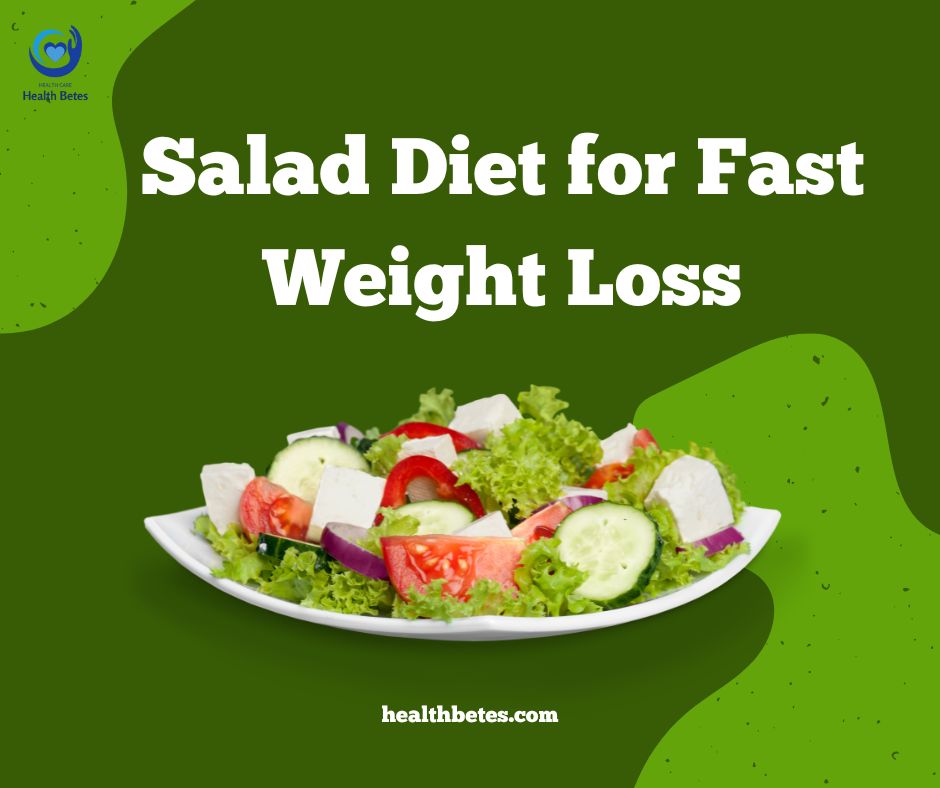Introduction: Why Salad Diets are a Game Changer
Many people think that salads are just bland and boring, often serving as a side dish to a main meal. But here’s the truth: salad diets can actually be a game-changer for your health, weight loss, and energy levels! In fact, a salad-based meal plan can do wonders for your body when done right, providing you with the nutrients, fiber, and vitamins that other diets might miss out on. So, if you’ve been thinking salads are just lettuce and tomatoes—think again!
A salad diet isn’t about limiting yourself to a plate of leaves every day. Instead, it’s about incorporating a variety of fresh ingredients that can fill you up, keep you energized, and help you reach your weight-loss goals. And here’s the best part: it’s easy to make, quick to prepare, and absolutely delicious! Whether you’re looking for a light lunch or a filling dinner, a salad diet for weight loss can easily be customized to your taste preferences.
Why You Should Choose a Salad Diet for Weight Loss
There’s a common myth that you need to starve yourself or eat tasteless meals to lose weight. But let’s break that myth right now. A salad diet for weight loss doesn’t mean you’re eating bland meals or restricting yourself to just a few leaves. In fact, salads are one of the most satisfying and filling meals you can have on your weight loss journey. Here’s why.
Salads are naturally low in calories but high in fiber, which means they’ll fill you up without causing you to overeat. You can add in nutrient-rich ingredients like protein-packed salads with chicken, tofu, or beans, and healthy fats from avocado, olive oil, or nuts. These ingredients help you feel satisfied for longer and prevent those pesky cravings between meals. So, if you’re looking for quick weight loss salads that don’t leave you hungry all the time, this is your go-to solution.
Plus, a salad diet is perfect for anyone trying to manage their weight or simply eat healthier. By sticking with low-calorie salads, you can incorporate a wide variety of ingredients without going over your calorie limit. Add fresh greens, colorful vegetables, and lean proteins like grilled chicken or tofu to your salads, and you’ll have a meal that’s filling, nutritious, and supports your weight loss goals.
You can also make weight loss salad recipes that are easy to prepare and pack for work or school. A salad diet isn’t just about eating salads for lunch—it’s about making them your main meals, which helps you stay on track with your weight management plan.
So, if you’re thinking of skipping the salad diet because you think it’s not filling or too restrictive—think again! With the right ingredients, a salad diet for weight loss can be incredibly satisfying and sustainable. All you need is a bit of creativity with your salad toppings and dressings to keep things interesting. And with the right balance of fiber-rich salads and protein-packed options, you can enjoy weight loss without feeling deprived.

Top Salad Recipes for a Healthy Salad Diet
Let’s get to the fun part—salad recipes! One of the best things about starting a salad diet is the endless variety of ingredients you can use to create exciting meals. You can switch up your recipes every day to keep things fresh and enjoyable. Whether you’re looking for a light lunch or a hearty dinner, here are a few healthy salad recipes to get you started.
Protein-Packed Salads: If you’re looking for something that will fill you up and keep your energy levels high, protein-packed salads are the way to go. You can toss in grilled chicken, quinoa, chickpeas, or tofu for a solid source of protein. These salads are perfect for muscle-building and making sure you’re getting the necessary nutrients while on a salad diet. Try adding ingredients like hard-boiled eggs, lean meats, or tempeh for a satisfying meal.
A great example of a protein-packed salad would be a chicken salad with mixed greens, avocado, cucumbers, and a light vinaigrette dressing. This salad provides protein, healthy fats, and fiber to keep you satisfied for hours.
Detox Salads: Want to cleanse your body while enjoying a fresh salad? Try incorporating detoxifying ingredients like kale, spinach, beets, and lemon. These ingredients not only help with digestion but also support your liver and kidney health. A simple detox salad could include cucumber, beets, cilantro, and lime, drizzled with olive oil for that added healthy fat boost. Detox salads are an easy and delicious way to help your body cleanse itself naturally while staying on track with your diet. you can also use detox drinks for weight loss
Low-Calorie Salads: For those looking to cut calories and manage their weight, low-calorie salads are an excellent choice. Lettuce, cucumbers, tomatoes, and bell peppers are just a few examples of low-calorie veggies you can toss into your salads. Add a sprinkle of seeds or nuts for crunch and a dash of healthy dressing for extra flavor. These salads are light but filling, making them the perfect choice for a low-calorie salad meal that doesn’t leave you hungry.
Here’s a simple low-calorie salad recipe: Toss together spinach, cherry tomatoes, cucumbers, red onions, and balsamic vinegar. This salad is fresh, low in calories, and packs a punch in terms of flavor. It’s the perfect addition to any weight loss meal plan.
Fiber-Rich Salads: One of the biggest benefits of a salad diet is the fiber content. Fiber keeps your digestive system healthy and helps you stay full longer. A great salad for this purpose would be one packed with avocado, beans, broccoli, and carrots. Not only will it boost your fiber intake, but it also delivers tons of vitamins and minerals your body needs.
A simple fiber-packed salad could include kale, chickpeas, red cabbage, and carrots, topped with a lemon-tahini dressing for an extra burst of flavor.
With these salad recipes, you’ll never feel bored or deprived while following a salad diet for weight loss. Feel free to experiment and mix up your ingredients to suit your taste preferences. The key is finding a balance of protein, healthy fats, and fiber that will keep you feeling full, satisfied, and energized throughout the day.

Meal Prep with Salad Diet: How to Make It Easy and Consistent
Meal prepping is a game-changer when it comes to sticking with a salad diet. By planning ahead, you can save time during the week and make sure you’re always ready with a healthy, filling salad on hand. A little bit of prep goes a long way when it comes to making a salad diet for weight loss work for you. Let’s break down how you can get started with meal prepping for a salad diet.
Start with the Base: The first step to successful meal prepping is to prepare the base of your salads. This could be greens like spinach, kale, arugula, or romaine lettuce. Wash, dry, and chop them, then store them in airtight containers or ziplock bags to keep them fresh. If you’re prepping for the week, it’s best to prep enough greens for 3-4 days. This way, you won’t be overwhelmed by a pile of chopped veggies every day.
Add the Protein: Protein is essential for keeping you full and maintaining muscle, so it’s a good idea to include some protein-packed options in your salads. Grill or bake chicken breast, turkey, or tofu. You can also prep beans like chickpeas or black beans, which work great in salads. Cook and store them in separate containers, so when it’s time to assemble your salads, you can just grab and go.
For example, if you’re making protein-packed salads, try grilling chicken or tofu on Sunday, and portion it out for use in salads later in the week. Adding protein to your salads makes them filling and helps you stay energized for longer.
Prepare Your Toppings: When it comes to toppings, you can get creative! Think nuts, seeds, croutons, cheese, or fresh fruit like berries or apples. Prep these ahead of time in small containers, so you can sprinkle them onto your salad whenever you’re ready to eat. Avoid adding dressings or toppings like avocado ahead of time, as they can get soggy or lose their freshness.
Dressing on the Side: It’s always a good idea to keep your salad dressing separate to avoid wilting greens. For a healthy salad meal prep, try making your own low-calorie dressings, such as balsamic vinaigrette, lemon-tahini, or a light olive oil-based dressing. You can prepare several different dressings in small jars to switch things up throughout the week.
By preparing all these components in advance, you’ll make sticking with a salad diet easy, fast, and stress-free. Plus, meal prepping saves you from falling into the trap of eating unhealthy takeout when you’re short on time.

Best Salad Dressings for Your Salad Diet
A salad isn’t complete without a delicious dressing, but it’s important to choose the right kind to keep your salad diet healthy and low-calorie. Store-bought dressings can often be packed with sugar, preservatives, and unhealthy fats, so making your own at home is always the better option.
Here are some of the best salad dressings you can make to enhance your salad diet for weight loss:
1. Balsamic Vinaigrette: This classic dressing is light and tangy, perfect for almost any salad. It’s made with just a few ingredients: balsamic vinegar, olive oil, Dijon mustard, salt, and pepper. It’s a healthy and low-calorie salad dressing option that complements both leafy greens and roasted vegetables.
2. Lemon-Tahini Dressing: If you’re looking for a creamy and flavorful dressing that’s also vegan, lemon-tahini is a great choice. Tahini, made from ground sesame seeds, is full of healthy fats and adds richness to your salad. Mix tahini with lemon juice, garlic, and a bit of water to create a smooth, creamy dressing that pairs beautifully with detox salads or roasted veggies.
3. Olive Oil & Lemon: Sometimes simplicity is best. A simple drizzle of extra virgin olive oil with fresh lemon juice makes an easy, refreshing dressing. You can also add a pinch of salt, pepper, and dried herbs like oregano or basil for extra flavor.
4. Avocado Dressing: If you want a creamy dressing but don’t want to use store-bought mayo or sour cream, avocado is the perfect alternative. Blend avocado with lemon, garlic, olive oil, and a touch of Greek yogurt for a creamy dressing that’s packed with healthy fats. This dressing works great for protein-packed salads and adds richness without the extra calories.
5. Yogurt-Based Dressing: For a creamy but lower-calorie option, try making a yogurt-based dressing. Greek yogurt is high in protein and can be used as a base for various dressings. Mix Greek yogurt with lemon juice, garlic, and a bit of olive oil for a creamy, zesty dressing that pairs perfectly with your fiber-rich salads.
These healthy salad dressings not only keep your salads fresh and exciting, but they also help maintain the nutritional integrity of your salad diet for weight loss. The key is to keep the ingredients simple and avoid using store-bought options with added sugars or unhealthy fats.

Common Mistakes to Avoid When Following a Salad Diet
While the salad diet can be a fantastic way to lose weight and eat healthier, there are a few common mistakes people make that can undo all their hard work. To ensure your salad diet is truly effective, let’s take a look at some things you should avoid.
1. Overloading on High-Calorie Dressings and Toppings
It’s easy to think that a salad is automatically healthy, but when you load it up with high-calorie dressings or toppings like creamy ranch, bacon bits, or fried croutons, you’re turning a low-calorie meal into something much heavier. While healthy fats like avocado and nuts are great in moderation, it’s important not to overdo it. Stick with a low-calorie salad dressing like balsamic vinaigrette or a lemon-tahini dressing to keep things light and flavorful. Remember, the dressing can be the hidden culprit that adds unnecessary calories, so always measure it out.
2. Skipping Protein
A common mistake when following a salad diet for weight loss is skipping protein altogether. While leafy greens and vegetables are great for fiber and vitamins, protein is essential for keeping you full and maintaining muscle mass. Make sure to add some protein-packed salads like grilled chicken, tofu, or beans to your meals. If you don’t include enough protein, you may find yourself feeling hungry and reaching for unhealthy snacks later in the day.
3. Not Having Enough Variety
Another mistake is making the same salad every day. Sure, salads are great, but eating the same ingredients over and over again can get boring and may lead to you losing interest in your salad diet. Mix things up by experimenting with different ingredients, such as switching from kale to spinach, or adding beets, broccoli, or berries to your salads. Include a variety of low-calorie salads, protein, and healthy fats to keep your meals exciting and nutritionally balanced.
4. Overthinking the Salad
Some people get caught up in making salads too complicated with too many ingredients. The key to a successful salad diet is simplicity and ease. A great salad doesn’t have to be filled with dozens of ingredients. Instead, focus on a few high-quality components like fresh greens, a protein source, some healthy fats, and a simple dressing. Don’t overthink it—make sure you include fiber-rich salads and a balance of macronutrients to stay satisfied.
5. Relying on Pre-Packaged Salads
Pre-packaged salads from the store may seem like an easy option, but they often contain preservatives, added sugars, and unhealthy fats in the dressings or toppings. It’s better to buy fresh ingredients and prepare your salads yourself. This way, you control what goes into your meals, ensuring they’re both fresh and healthy.
To really make your salad diet for weight loss work, focus on quality ingredients, balance, and moderation. Avoid the mistakes above, and you’ll be well on your way to enjoying a successful and sustainable salad-based lifestyle!

The Benefits of a Salad Diet Beyond Weight Loss
While the main focus of a salad diet might be weight loss, there are so many additional benefits that come along with it! A salad diet doesn’t just help you shed pounds; it also promotes overall health and wellness in ways you might not expect.
1. Improved Digestion
Salads, especially those filled with leafy greens like spinach and kale, are rich in fiber. Fiber is essential for keeping your digestive system in tip-top shape. It helps regulate bowel movements, prevent constipation, and supports the healthy function of your gut. A fiber-rich salad can be a natural way to keep your digestive system functioning smoothly.
2. Glowing Skin
Did you know that the right salad ingredients can give your skin a healthy glow? Veggies like carrots, spinach, and avocados are rich in antioxidants and healthy fats, which help reduce inflammation and promote healthy, youthful skin. Eating more antioxidant-rich salads helps protect your skin from the inside out, giving you that radiant, dewy look.
3. Boosted Energy
A healthy salad diet can give you more energy throughout the day. Instead of reaching for sugary snacks, which cause energy crashes, try incorporating nutrient-dense salads into your meals. Fresh vegetables, lean proteins, and healthy fats will fuel your body, keeping your energy levels steady and preventing mid-afternoon slumps.
4. Better Heart Health
Many salad ingredients, especially leafy greens, nuts, and seeds, are heart-healthy. They contain essential vitamins, minerals, and healthy fats like omega-3s, which help reduce inflammation and support a healthy cardiovascular system. A salad diet for weight management often includes foods that can help lower blood pressure and cholesterol levels, reducing the risk of heart disease.
5. Detoxification
Certain ingredients in salads, such as beets, cucumbers, and cilantro, are known for their detoxifying properties. They help flush out toxins from your body, cleanse your liver, and promote overall well-being. A detox salad can help your body stay clean and healthy while supporting your natural detoxification processes.
So, while a salad diet might be most popular for its weight-loss benefits, it’s also a powerhouse for overall health. By including the right ingredients, you can enjoy better digestion, healthier skin, more energy, a stronger heart, and a naturally detoxified body.

How to Customize Your Salad Diet for Different Goals
One of the best things about a salad diet is its flexibility. Whether you’re looking to lose weight, build muscle, detoxify, or simply eat healthier, you can easily tailor your salads to meet your unique goals. Let’s break down how you can customize your salad diet for weight loss and other health benefits.
1. For Weight Loss: Low-Calorie, High-Fiber Salads
When your primary goal is weight loss, it’s important to focus on low-calorie salads that are still nutrient-dense and filling. You’ll want to incorporate lots of fiber-rich ingredients like leafy greens (think spinach, kale, arugula), along with low-calorie veggies like cucumbers, tomatoes, and bell peppers.
Add a small portion of healthy fats like avocado or olive oil to help keep you satisfied, but keep the portions in check to avoid excess calories. For protein, opt for lean meats like grilled chicken or plant-based options like chickpeas or tofu. These will help you maintain muscle while burning fat. A great example of a low-calorie salad for weight loss could be a simple combination of spinach, grilled chicken, cherry tomatoes, cucumbers, and a light balsamic vinaigrette.
The key here is to keep your portions in control while making sure your salad is filling enough to curb your hunger without causing a calorie overload.
2. For Muscle Gain: Protein-Packed Salads
If you’re looking to build muscle, your salad diet should be rich in protein to support muscle growth and recovery. Think of adding protein sources like chicken, turkey, grilled shrimp, tofu, or beans to your salads. Also, include quinoa or eggs for additional protein and healthy fats.
For example, a great protein-packed salad could feature grilled chicken breast, avocado, quinoa, leafy greens, and a mix of colorful vegetables like bell peppers, carrots, and red onions. Dress it with a simple lemon-tahini dressing to add flavor without too many extra calories.
The more protein-packed your salads are, the more fuel you give your muscles for recovery and growth.
3. For Detox: Cleansing and Nourishing Salads
A detox salad can be the perfect way to cleanse your body and support your liver and kidney health. Ingredients like beets, cucumbers, cilantro, and lemon are natural detoxifiers. These ingredients work together to flush toxins from the body and promote overall wellness.
Try combining kale or spinach with beets, cilantro, and carrots. Add a sprinkle of chia seeds for an extra boost of fiber and omega-3 fatty acids. A light apple cider vinegar dressing with lemon and olive oil will add some tang and enhance the detoxifying effects.
Detox salads aren’t just about cleansing, though—they’re also a great way to feel refreshed and energized, helping you feel your best throughout the day.
4. For a Mediterranean Twist: Heart-Healthy Salads
If you’re looking for a heart-healthy salad diet, the Mediterranean diet is a great inspiration. Mediterranean salads are full of healthy fats, omega-3s, and antioxidants, which can lower blood pressure and improve heart health. Focus on ingredients like olive oil, avocados, tomatoes, olives, and feta cheese.
A classic Mediterranean salad could include cucumbers, cherry tomatoes, red onions, olives, and feta cheese, drizzled with olive oil and lemon juice. This salad is loaded with heart-healthy fats and antioxidants, making it perfect for anyone who wants to improve cardiovascular health.
5. For a Vegan/Vegetarian Approach: Plant-Based Salads
If you’re following a vegan or vegetarian diet, you can easily make your salad diet plant-based. Start with a base of leafy greens and then add a variety of plant-based proteins like chickpeas, lentils, quinoa, edamame, or tofu. Don’t forget to toss in plenty of colorful veggies like beets, sweet potatoes, carrots, and avocado.
A great vegan salad might feature spinach, chickpeas, avocado, cucumber, and red cabbage, topped with a simple olive oil and lemon dressing. You can even add a handful of seeds like pumpkin or sunflower seeds for an extra protein and crunch factor.
No matter what your goal is, customizing your salad diet to suit your personal needs is incredibly easy. The beauty of salads lies in their versatility, so you can tailor them to be as filling, energizing, or detoxifying as you need.

Conclusion: Start Your Salad Diet Today
Now that you know the many benefits of a salad diet, the next step is to get started. Remember, a salad diet isn’t just about eating greens—it’s about finding the right balance of ingredients to meet your health and fitness goals. Whether you’re aiming for weight loss, muscle gain, detoxing, or simply improving your heart health, salads are a fantastic way to get the nutrients your body needs without compromising on taste.
So, why not start your salad diet today? Plan out a simple meal prep for the week, add your favorite protein-packed salads, and experiment with delicious detox salads. With a little planning and creativity, you can easily turn salads into a satisfying, nutrient-rich meal that supports all your health goals.
Give it a try and let the fresh, delicious flavors of salads work their magic for you. Your body will thank you for it!
Frequently Asked Questions (FAQs)
1. Can a salad diet really help with weight loss?
Yes, a salad diet for weight loss can definitely help! Salads are low in calories but packed with fiber and nutrients, which makes them filling without going over your daily calorie count. By including protein and healthy fats, you’ll stay satisfied for longer and avoid snacking on unhealthy foods. As long as you’re mindful of your portions and dressings, a salad diet can be an effective weight loss tool.
2. What should I include in my salad to make it more filling?
To make your salad more filling, focus on including a balance of protein, healthy fats, and fiber-rich ingredients. For example, you can add grilled chicken, tofu, chickpeas, or quinoa for protein. Toss in some avocado, olive oil, or nuts for healthy fats, and add plenty of leafy greens and colorful veggies for fiber. A combination of these will keep you feeling full and energized throughout the day.
3. Can I eat salads every day?
Absolutely! Eating salads every day can be a great way to incorporate more vegetables into your diet. The key is to mix things up and vary your ingredients to prevent boredom and ensure you’re getting a wide range of nutrients. If you’re worried about not getting enough protein or fats, just make sure you’re adding a variety of protein sources (like chicken, tofu, beans) and healthy fats (like avocado and olive oil).
4. How do I make my salad diet more interesting?
If you find yourself getting tired of the same old salads, it’s time to get creative! Experiment with different veggies, fruits, proteins, and dressings. Add things like roasted sweet potatoes, quinoa, beets, or even fruit like strawberries and apples. Switch up your dressings and toppings, or try a new salad recipe each week. The possibilities are endless—make your salad meals fun and flavorful!
5. Are salad diets suitable for people with dietary restrictions?
Yes, salad diets are highly customizable and can easily be tailored to suit different dietary needs, including vegan, gluten-free, keto, or low-carb diets. For example, if you’re vegan, you can skip animal-based products and focus on plant-based proteins like tofu, chickpeas, and lentils. If you’re on a keto diet, focus on low-carb vegetables, avocado, and olive oil. Just make sure to include the right balance of ingredients that meet your nutritional needs.
6. How can I avoid overeating salads?
Salads are healthy, but it’s easy to go overboard with dressings, toppings, or large portions. To avoid overeating, measure your portions and be mindful of your calorie intake. Stick to a low-calorie salad dressing (like balsamic vinaigrette) and avoid adding too many calorie-dense toppings like cheese, croutons, or fatty dressings. Eating protein-packed salads will also help curb hunger and keep you from overeating.
7. Can I lose weight with a salad diet if I don’t exercise?
While exercise is important for overall health, you can still lose weight on a salad diet even if you’re not exercising regularly. A salad diet for weight loss is effective because it focuses on low-calorie, nutrient-dense foods that fill you up. However, adding regular exercise to your routine can speed up your weight loss and improve overall health.
8. What are some easy salad recipes for beginners?
If you’re new to the salad diet, start with simple recipes like a Mediterranean salad with cucumbers, tomatoes, olives, and feta cheese, or a protein-packed salad with grilled chicken, avocado, spinach, and balsamic vinaigrette. There are plenty of easy, beginner-friendly options that will get you comfortable with making salads as your primary meals.
9. How can I make my salads more flavorful?
The key to a flavorful salad lies in the combination of fresh ingredients and the right dressing. Use fresh, seasonal vegetables, and try adding herbs like basil, cilantro, or parsley. Don’t forget to experiment with different dressings—lemon-tahini, avocado-based dressings, or balsamic vinaigrette can add a lot of flavor without excess calories. Toppings like seeds, nuts, and cheese also help enhance the taste.
10. How do I store salads for meal prep?
For meal prepping, it’s best to keep the dressing separate from the salad to avoid wilting. Store your salad ingredients (greens, veggies, proteins) in airtight containers or ziplock bags, and store the dressing in small containers on the side. This will keep everything fresh, and you can easily grab a healthy meal when needed.


